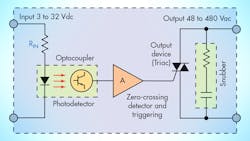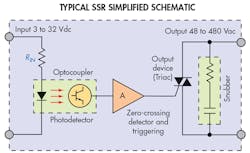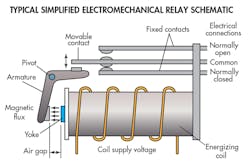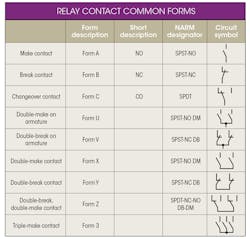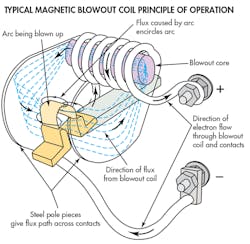Engineering Essentials: Relays and Contactors
Download this article in .PDF format
Relays and contactors use a variety of technologies to switch signals and power connections. Many devices called relays use similar techniques and topologies, but the terminology can be confusing. Here are a few of the basic differences that distinguish different types of relay and contactor switches.
Solid-state relays (SSRs) control load currents through use of solid-state switches such as Triacs, SCRs (silicon-controlled rectifiers), or power transistors. The input signals that control switching typically enter the device through isolation mechanisms such as transformers, reed relays, or optoisolators. These isolation mechanisms prevent the high-power load current from inadvertently outing back to the relay input in case of a failure.
Some SSRs incorporate snubber circuits or zero-crossing detectors to reduce spikes and transients generated when the SSR switches the load current through an inductive load where the sudden interruption of current flow leads to a sharp rise in voltage across the relay via Faraday's law. A voltage generated across the relay that is beyond what it is designed to tolerate may damage or destroy it. The snubber, usually a reverse-connected diode, provides a short-term alternative current path around the relay-switching device that lets the inductive element discharge.
Typical SSR applications are those where rapid on/off cycling would quickly wear out conventional electromechanical relays. General-purpose SSRs have on/off cycle lifetimes as high as 100,000 actuations. SSRs that can be actuated with conventional CMOS and TTL logic-level voltages are available.
Electromechanical relays open and close electrical contacts to turn a load off and on. Most electromechanical relays contain a moving component called an armature that is attracted by the magnetic field the coil generates. They are often used because they cost less than corresponding electronic switches. But some or their qualities are superior to those of SSRs. For example, electromechanical relays can have numerous contacts electrically isolated one from another. Electromechanical relays also have a contact resistance that tends to be lower than that of SSRs (tens of milliohms versus about 100 Ω). Contact capacitance is also less, which may benefit high-frequency circuits. Electromechanical relays are less likely to be turned on by transients than SSRs and may be less easily damaged by brief short circuits or overloads.
Electromechanical relays differ in other important ways from SSRs. First, relay coils are highly inductive, and the inductance value is not constant. Inductance is low immediately after energization and rises as current approaches a steady-state level and the relay armature closes. In contrast, SSRs have mainly resistive inputs and a constant input current.
Second, electromechanical relays switch much more slowly than SSRs (typically 5 to 15 msec versus about 1 msec). Coil inductance is the primary cause, but the mass of armature and contact structures are also factors.
Third, relay coil inductance can produce high-voltage transients when the device deenergizes. Snubber circuits can reduce the transients but can delay relay dropout as well. Arcs at the contacts of electromechanical relays can produce EMI when a contact bounces during opening or closing.
: A reed relay consists of reed switches within an operating coil. A reed switch contains a pair (or more) of magnetizable, flexible, metal reeds whose end portions are separated by a small gap when the switch is open. The reeds are hermetically sealed in opposite ends of a tubular glass envelope. In reed relays, a magnetic field from a coil forces the reeds together, thus closing the contacts. The stiffness of the reeds causes them to separate and open the circuit, when the magnetic field ceases.
The number of reeds a given relay can accommodate is limited by the coil size. Most manufacturers limit coil size to handle 12 standard switches at most. Reed relays are available with contact forms from 1A to 12A, 1B to 8B, 1C to 4C, and combinations of these.
Dc relays: A dc relay uses a single coil of wire wound around the iron core to make the electromagnet. When the dc coil energizes, the core generates a steady magnetic field that holds the armature closed.
Ac relays: In theory, ac can be used to operate a dc relay. But ac drops to zero every half cycle. Thus, the relay armature tends to release every half cycle. This continual movement of the armature tends to result in an audible buzz and can open and close the contacts as the armature moves. To make a relay compatible with ac, most manufacturers install a shader ring (or shader coil) on the top of the coil core. The shader ring forces the magnetism developed in part of the core to lag that of the remainder of the core. Thus, there is a slight phase displacement between the magnetism in the two parts of the core.
The purpose of the shader ring is to ensure some magnetic energy remains in the core during each half cycle when ac current drops to zero. The energy holds the armature closed until energy in the unshaded portion of the core builds up again.
Most ac applications are for 60-Hz current. Telephone relays operate on 20-Hz current but are similar in construction. For 400-Hz current, as found in aircraft, a radical departure from the 60-Hz relay construction is necessary. Reliable performance is attained by rectifying the 400-Hz ac to dc and using a dc relay motor.
Safety relays can be thought of as a cross between a relay and a controller. As their name implies, they are designed to control safety circuits and shut off primary power to a machine in the event of a hazardous situation. Power to the machine primary control elements (MPCE) gets connected through the output contacts of the safety relay. Inputs to the safety relay typically come from safety devices such as emergency stop switches, limit switches, or safety interlock switches. Safety relays also typically incorporate redundant contacts as part of their safety measures.
The safety relay monitors its own safety contacts. If there is a fault in the operation of one of the monitoring relay contacts, the safety relay shuts down, removes power from the MPCE and prevents a start or successive cycle of the machine until the fault clears. In addition, the relay typically can monitor the contacts of the MCPE or of an external safety relay.
can be thought of as a combination of an analog or digital meter reading out a measured variable, mated with a switching function. The relays operate alarm and control devices when the monitored signal value moves outside chosen setpoint limits. Typical devices can be found with one relay and one or two setpoints, or two relays handling two setpoints. Common applications include liquid level control, load shedding, power factor correction, and over/undertemperature monitoring. (Devices for the latter application are equipped with special-purpose RTD or thermocouple inputs.)
Contactors can be viewed as special-purpose relays designed for repeatedly establishing and interrupting high-power circuits. Most integral horsepower motors (1 hp and above) are controlled with contactors. In addition, contactors designed for use with motors frequently incorporate overload heaters in each controlled phase.
Contactors are packaged according to either IEC or NEMA standards. IEC devices can be 30 to 70% smaller than their NEMA counterparts because of differences in rating practices. In addition, NEMA devices more heavily rely on mass to dissipate heat from arcing whereas IEC devices reduce heat at their contacts through electromagnetic arc quenching techniques. The typical approach is to use a second special set of arcing contacts designed to reduce the amount of arcing across the main contacts together with so-called blowout coils which generate a magnetic field designed to push the arc away from the contact area.
Contactors often incorporate overload heaters in each phase. The heater element is a low-resistance strip of metal or an assembly that heats up as the motor draws current. If the heater temperature reaches a point that corresponds to a moderate overloading of the motor, a normally closed switch will open. This normally closed contact usually connects in series with the relay coil, so its opening automatically deenergizes the relay, thereby powering down the motor.
Overload heaters are intended to provide overcurrent protection for large electric motors. This is in contrast with circuit breakers and fuses, which primarily provide overcurrent protection for power conductors.
After tripping, the heaters are designed to cool at the same rate as the motor they protect so they accurately reflect the motor's thermal condition and will not permit power to be reapplied until the motor is cool enough to start up again. Some contactors may also incorporate a pushbutton for manually resetting the normally closed switch contact after a heater temperature trip.
The typical overload heater uses bimetal as a heat-sensitive element where two different metals are fixed together along one side. When heated, the strip deflects because one metal expands more than the other. The deflection opens the relay contact to open.
Other technologies used for heat sensing include what’s called a single-metal heater. Here, the metal forms a tube, which lengthens when heated to open the relay contact. Older devices may use solder-pot heat sensing. Here, a metal cylinder and hollow tube are normally held together by a film of solder. When the device overheats, the solder melts and breaks the connection between the cylinder and tube, releasing the tripping device. The solder cools after the relay trips. Finally, induction heaters use a coil in the motor circuit that surrounds a copper tube. The tube acts as a short-circuited secondary of a transformer, which gets heated by induced current. A bimetallic strip usually sits in the tube and serves as the heat-sensitive element. Induction heaters are typically used only for ac contactors.
Definite-purpose contactors can be found in use for compressor motors powering HVAC systems. The definite-purpose moniker refers to a design philosophy wherein the contactor is built to last only as long as its intended application. This contrasts with NEMA-rated devices which tend to be rated conservatively and may outlast the equipment on which they are installed. The market for definite-purpose contactors (and starters) is primarily in North America. IEC-rated contactors usually handle HVAC applications elsewhere.
Definite-purpose contactors can also be found in other types of heating, cooling, and refrigeration applications. In general, these devices fall into two categories: compact one and two-pole contactors (handling between 20 and 40 A), and standard-frame devices handling between 15 and 360 A. Residential central-air-conditioning uses account for most of the applications in the first category, while larger commercial/industrial rooftop A/C units make up most of the latter.
Capacitor-switching contactors are specially designed to switch banks of capacitors. The sudden switching of a large amount of capacitance can generate large initial current flows. To limit potentially severe inrush current, capacitor-switching contactors typically incorporate series-mounted resistor elements designed to reduce stress on the contactor and the capacitors.
About the Author
Leland Teschler
Lee Teschler served as Editor-in-Chief of Machine Design until 2014. He holds a B.S. Engineering from the University of Michigan; a B.S. Electrical Engineering from the University of Michigan; and an MBA from Cleveland State University. Prior to joining Penton, Lee worked as a Communications design engineer for the U.S. Government.
